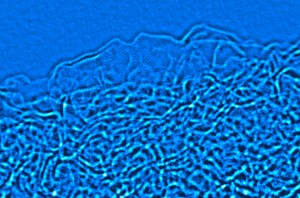Researchers: New 'supercapacitor' acts like energy sponge

Chalk one up for the supercapacitor side in the ongoing debate about the role of batteries versus supercapacitors for serious energy storage applications. Energy storage is seen as not only critical for the adoption of electrical vehicles but also for helping with people get past the intermittent nature of alternative energy technologies such as wind or solar.

Atomic resolution electron micrograph of activated graphene. The images show that the material is composed of single sheets of crystalline carbon, which are highly curved to form a three-dimensional porous network.
Scientists at the Brookhaven National Laboratory have discovered that by adding a form of "activated graphene" to supercapacitors, they can help enhance the latter's ability to soak up more energy -- while holding onto their ability to charge and release energy quickly. The material was developed by researchers at the University of Texas, Austin, and it is the subject of a paper published in the May 2011 issue of Science. The reason this is interesting and relevant is because supercapacitors typically haven't been able to hold as much charge as battery alternatives.
Said Eric Stach, who is one of the co-authors of the paper:
"Those properties make this new form of carbon particularly attractive for meeting electrical energy storage needs that also require a quick release of energy -- for instance in electric vehicles or to smooth out power availability from intermittent energy sources, such as wind and solar power."
The material in question is a more porous form of carbon (yep, carbon) that uses potassium hydroxide to restructure graphene platelets at the nanoscale and "activate" them. This material typically is used in filters or in supercapacitor applications.
You can read more about the potential of graphene as a green technology in some posts over at ZDNet sister site, SmartPlanet: